Operations Management Assignment Solution: Questions and Analysis
VerifiedAdded on 2022/11/24
|6
|1304
|433
Homework Assignment
AI Summary
This document provides a comprehensive solution to an operations management assignment, addressing five key questions. The first question explores the deployment of automation and advanced process technologies in situations where production know-how is largely implicit, considering the impact of Artificial Intelligence and using examples like Toyota. The second question analyzes Vendor Managed Inventory (VMI) strategies, comparing the supply chains of 7-Eleven Japan, Zara, and Steinway. The third question evaluates the reasonableness of a 95% service level policy for critical spare parts in a military base. The fourth question suggests ways to improve the sustainability and compliance of a company's supply chain, using Zara as an example. Finally, the fifth question discusses the risks associated with outsourcing production to companies in different countries, such as Li & Fung and Foxconn. The assignment leverages concepts of supply chain management, inventory control, and strategic decision-making.
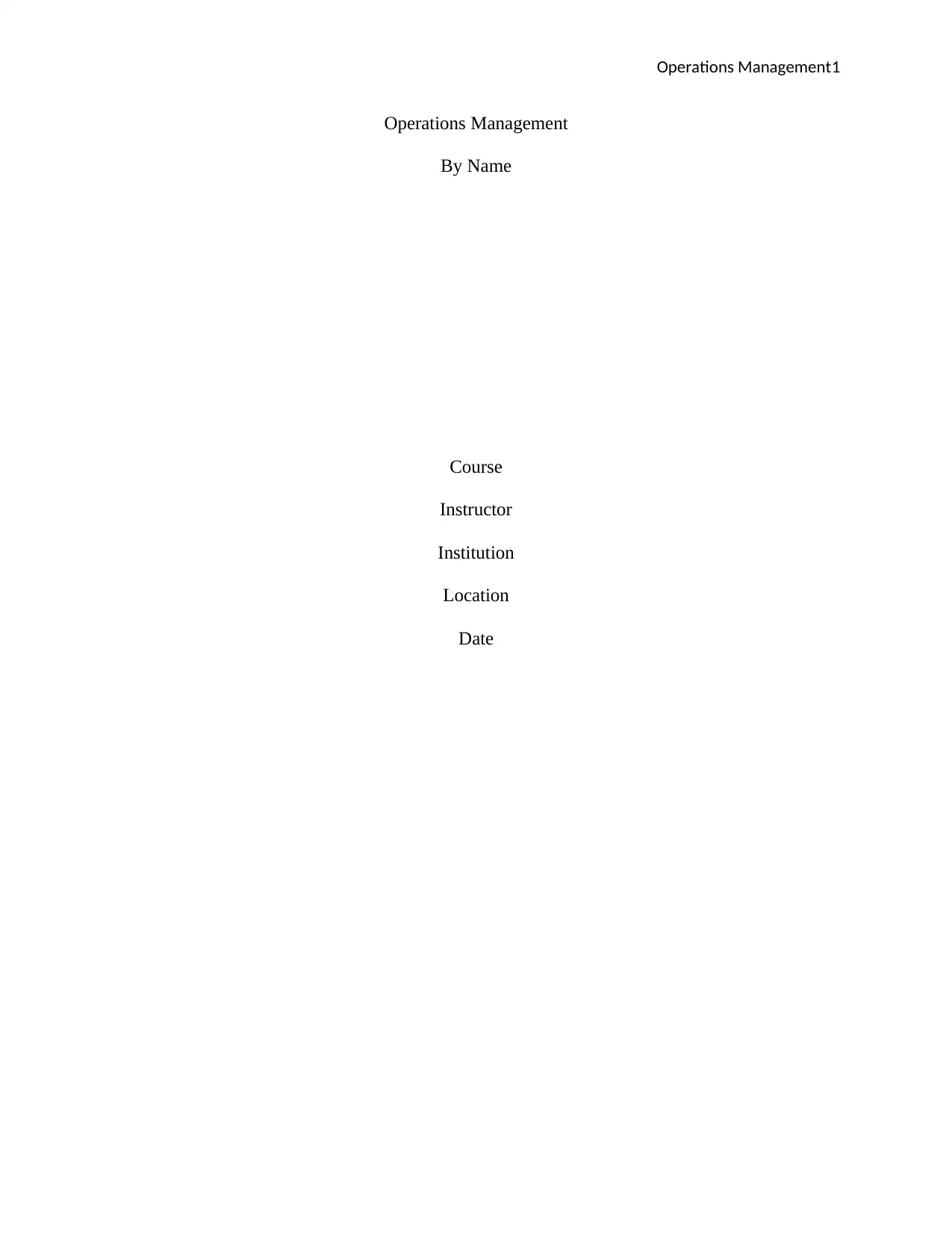
Operations Management1
Operations Management
By Name
Course
Instructor
Institution
Location
Date
Operations Management
By Name
Course
Instructor
Institution
Location
Date
Paraphrase This Document
Need a fresh take? Get an instant paraphrase of this document with our AI Paraphraser
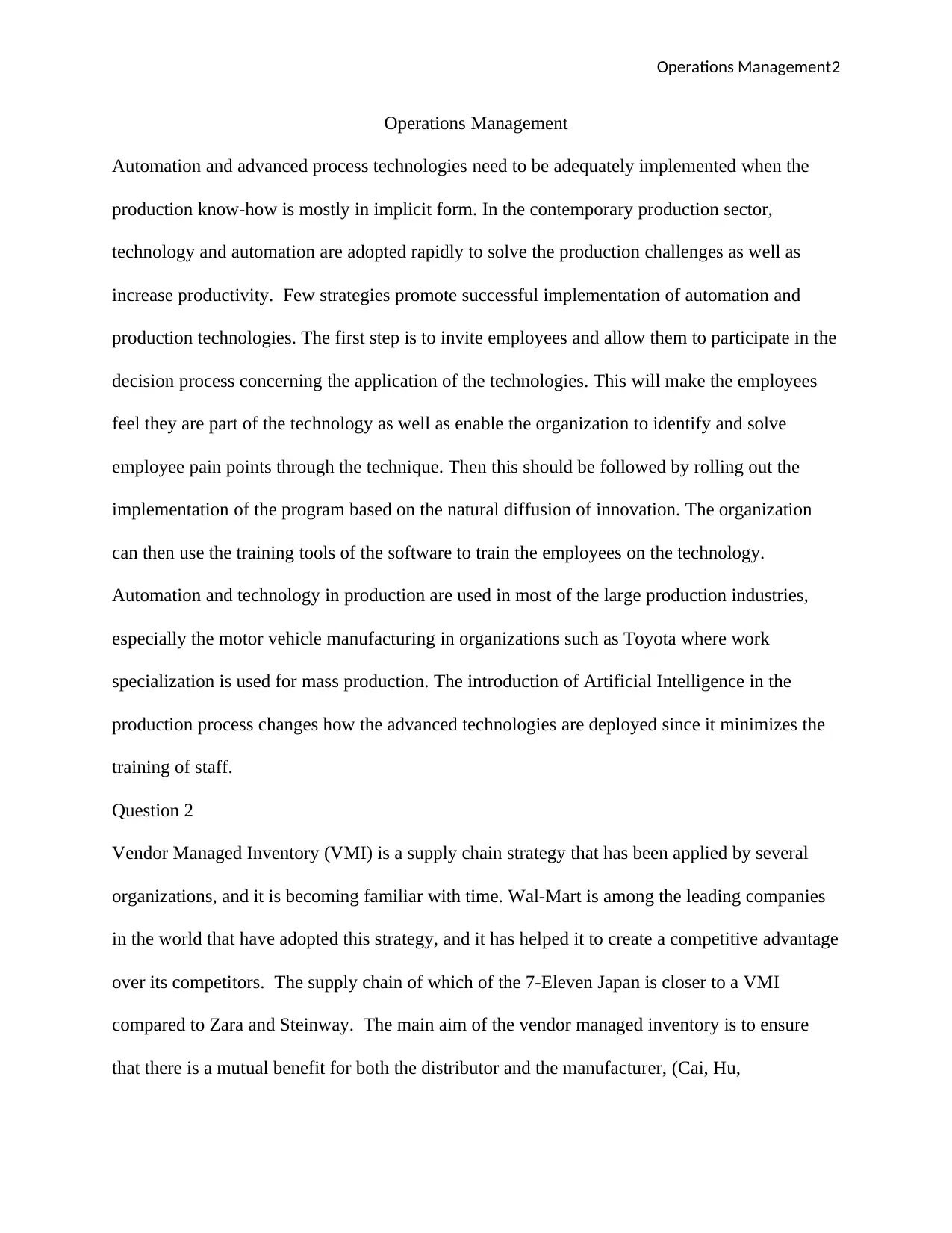
Operations Management2
Operations Management
Automation and advanced process technologies need to be adequately implemented when the
production know-how is mostly in implicit form. In the contemporary production sector,
technology and automation are adopted rapidly to solve the production challenges as well as
increase productivity. Few strategies promote successful implementation of automation and
production technologies. The first step is to invite employees and allow them to participate in the
decision process concerning the application of the technologies. This will make the employees
feel they are part of the technology as well as enable the organization to identify and solve
employee pain points through the technique. Then this should be followed by rolling out the
implementation of the program based on the natural diffusion of innovation. The organization
can then use the training tools of the software to train the employees on the technology.
Automation and technology in production are used in most of the large production industries,
especially the motor vehicle manufacturing in organizations such as Toyota where work
specialization is used for mass production. The introduction of Artificial Intelligence in the
production process changes how the advanced technologies are deployed since it minimizes the
training of staff.
Question 2
Vendor Managed Inventory (VMI) is a supply chain strategy that has been applied by several
organizations, and it is becoming familiar with time. Wal-Mart is among the leading companies
in the world that have adopted this strategy, and it has helped it to create a competitive advantage
over its competitors. The supply chain of which of the 7-Eleven Japan is closer to a VMI
compared to Zara and Steinway. The main aim of the vendor managed inventory is to ensure
that there is a mutual benefit for both the distributor and the manufacturer, (Cai, Hu,
Operations Management
Automation and advanced process technologies need to be adequately implemented when the
production know-how is mostly in implicit form. In the contemporary production sector,
technology and automation are adopted rapidly to solve the production challenges as well as
increase productivity. Few strategies promote successful implementation of automation and
production technologies. The first step is to invite employees and allow them to participate in the
decision process concerning the application of the technologies. This will make the employees
feel they are part of the technology as well as enable the organization to identify and solve
employee pain points through the technique. Then this should be followed by rolling out the
implementation of the program based on the natural diffusion of innovation. The organization
can then use the training tools of the software to train the employees on the technology.
Automation and technology in production are used in most of the large production industries,
especially the motor vehicle manufacturing in organizations such as Toyota where work
specialization is used for mass production. The introduction of Artificial Intelligence in the
production process changes how the advanced technologies are deployed since it minimizes the
training of staff.
Question 2
Vendor Managed Inventory (VMI) is a supply chain strategy that has been applied by several
organizations, and it is becoming familiar with time. Wal-Mart is among the leading companies
in the world that have adopted this strategy, and it has helped it to create a competitive advantage
over its competitors. The supply chain of which of the 7-Eleven Japan is closer to a VMI
compared to Zara and Steinway. The main aim of the vendor managed inventory is to ensure
that there is a mutual benefit for both the distributor and the manufacturer, (Cai, Hu,
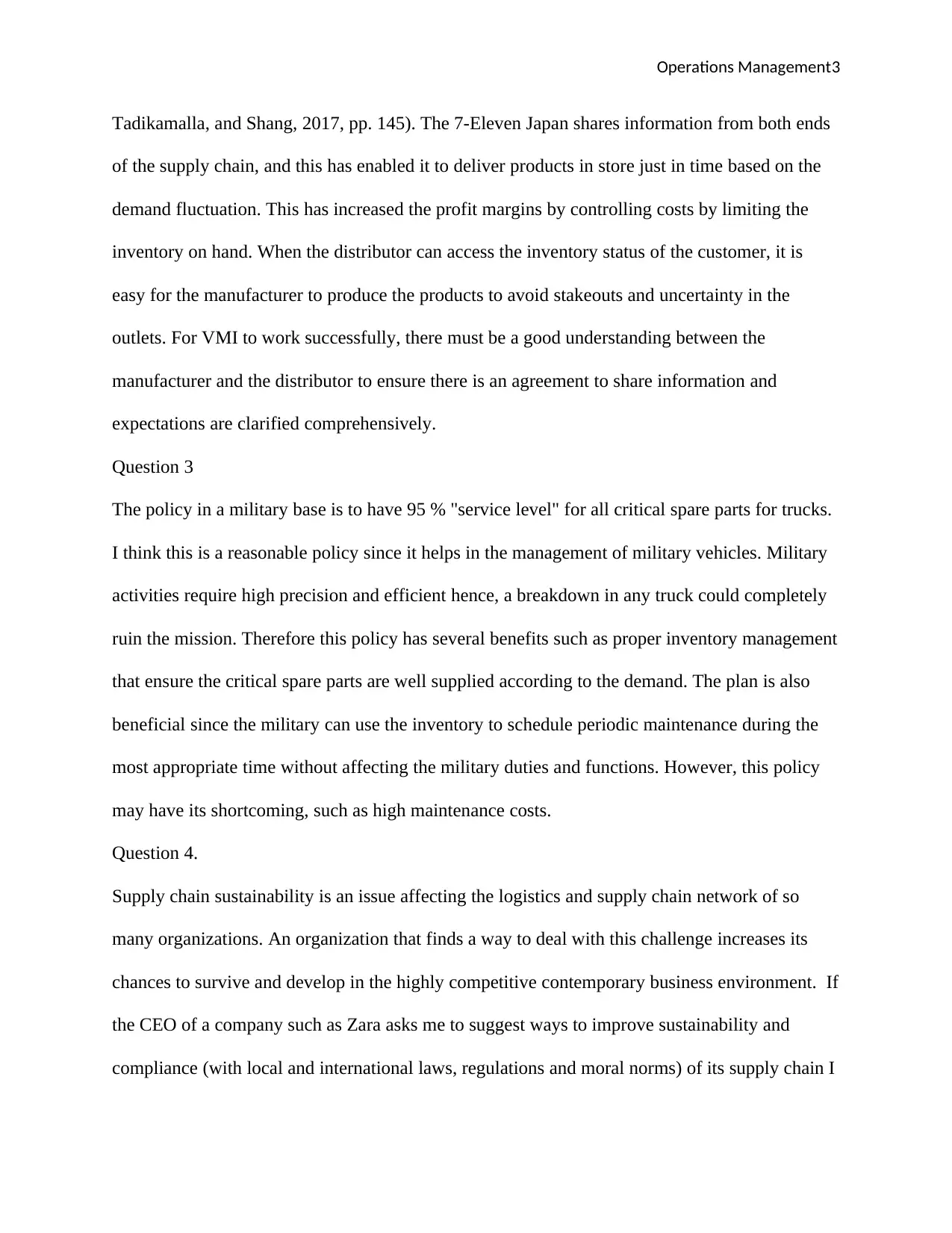
Operations Management3
Tadikamalla, and Shang, 2017, pp. 145). The 7-Eleven Japan shares information from both ends
of the supply chain, and this has enabled it to deliver products in store just in time based on the
demand fluctuation. This has increased the profit margins by controlling costs by limiting the
inventory on hand. When the distributor can access the inventory status of the customer, it is
easy for the manufacturer to produce the products to avoid stakeouts and uncertainty in the
outlets. For VMI to work successfully, there must be a good understanding between the
manufacturer and the distributor to ensure there is an agreement to share information and
expectations are clarified comprehensively.
Question 3
The policy in a military base is to have 95 % "service level" for all critical spare parts for trucks.
I think this is a reasonable policy since it helps in the management of military vehicles. Military
activities require high precision and efficient hence, a breakdown in any truck could completely
ruin the mission. Therefore this policy has several benefits such as proper inventory management
that ensure the critical spare parts are well supplied according to the demand. The plan is also
beneficial since the military can use the inventory to schedule periodic maintenance during the
most appropriate time without affecting the military duties and functions. However, this policy
may have its shortcoming, such as high maintenance costs.
Question 4.
Supply chain sustainability is an issue affecting the logistics and supply chain network of so
many organizations. An organization that finds a way to deal with this challenge increases its
chances to survive and develop in the highly competitive contemporary business environment. If
the CEO of a company such as Zara asks me to suggest ways to improve sustainability and
compliance (with local and international laws, regulations and moral norms) of its supply chain I
Tadikamalla, and Shang, 2017, pp. 145). The 7-Eleven Japan shares information from both ends
of the supply chain, and this has enabled it to deliver products in store just in time based on the
demand fluctuation. This has increased the profit margins by controlling costs by limiting the
inventory on hand. When the distributor can access the inventory status of the customer, it is
easy for the manufacturer to produce the products to avoid stakeouts and uncertainty in the
outlets. For VMI to work successfully, there must be a good understanding between the
manufacturer and the distributor to ensure there is an agreement to share information and
expectations are clarified comprehensively.
Question 3
The policy in a military base is to have 95 % "service level" for all critical spare parts for trucks.
I think this is a reasonable policy since it helps in the management of military vehicles. Military
activities require high precision and efficient hence, a breakdown in any truck could completely
ruin the mission. Therefore this policy has several benefits such as proper inventory management
that ensure the critical spare parts are well supplied according to the demand. The plan is also
beneficial since the military can use the inventory to schedule periodic maintenance during the
most appropriate time without affecting the military duties and functions. However, this policy
may have its shortcoming, such as high maintenance costs.
Question 4.
Supply chain sustainability is an issue affecting the logistics and supply chain network of so
many organizations. An organization that finds a way to deal with this challenge increases its
chances to survive and develop in the highly competitive contemporary business environment. If
the CEO of a company such as Zara asks me to suggest ways to improve sustainability and
compliance (with local and international laws, regulations and moral norms) of its supply chain I
⊘ This is a preview!⊘
Do you want full access?
Subscribe today to unlock all pages.

Trusted by 1+ million students worldwide
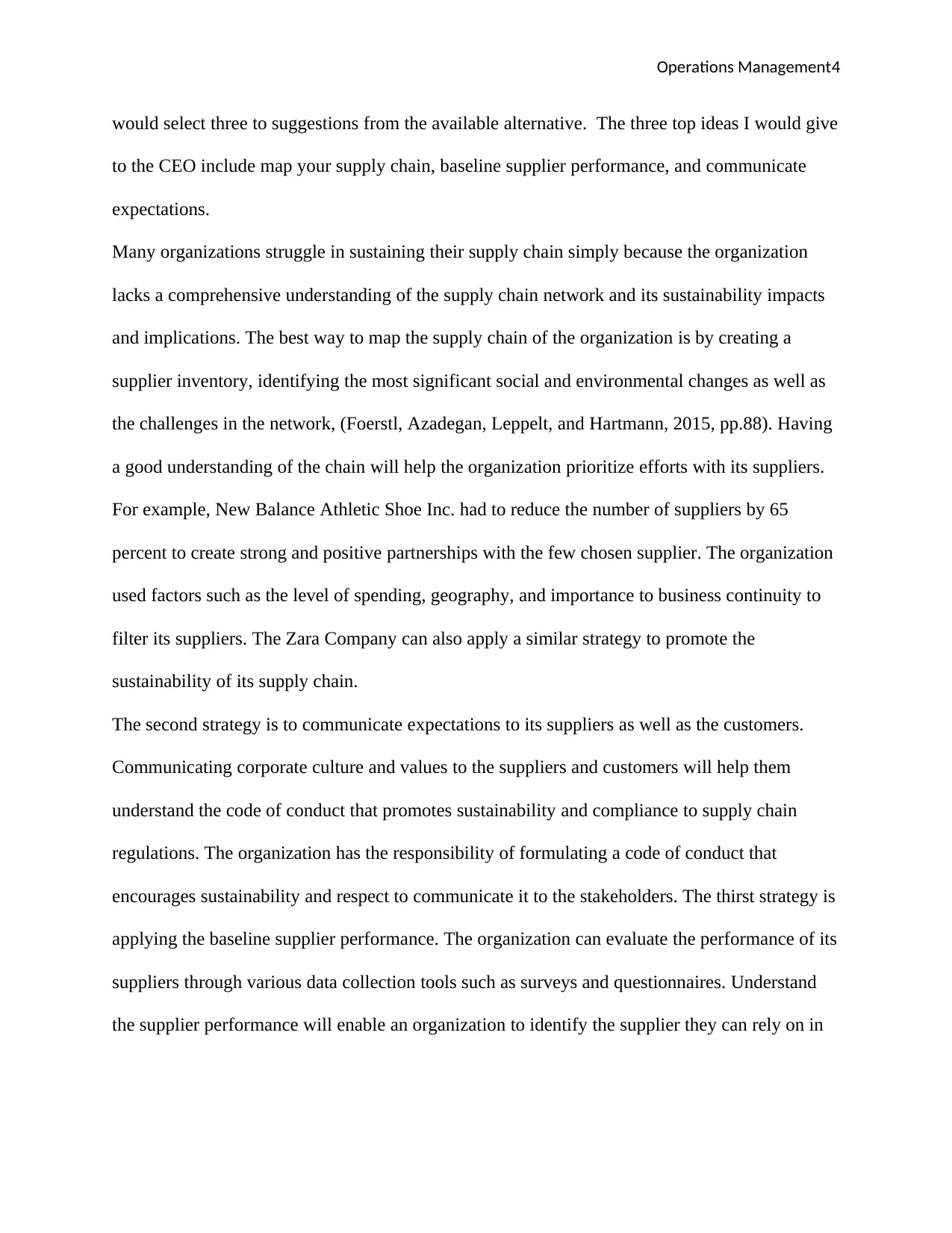
Operations Management4
would select three to suggestions from the available alternative. The three top ideas I would give
to the CEO include map your supply chain, baseline supplier performance, and communicate
expectations.
Many organizations struggle in sustaining their supply chain simply because the organization
lacks a comprehensive understanding of the supply chain network and its sustainability impacts
and implications. The best way to map the supply chain of the organization is by creating a
supplier inventory, identifying the most significant social and environmental changes as well as
the challenges in the network, (Foerstl, Azadegan, Leppelt, and Hartmann, 2015, pp.88). Having
a good understanding of the chain will help the organization prioritize efforts with its suppliers.
For example, New Balance Athletic Shoe Inc. had to reduce the number of suppliers by 65
percent to create strong and positive partnerships with the few chosen supplier. The organization
used factors such as the level of spending, geography, and importance to business continuity to
filter its suppliers. The Zara Company can also apply a similar strategy to promote the
sustainability of its supply chain.
The second strategy is to communicate expectations to its suppliers as well as the customers.
Communicating corporate culture and values to the suppliers and customers will help them
understand the code of conduct that promotes sustainability and compliance to supply chain
regulations. The organization has the responsibility of formulating a code of conduct that
encourages sustainability and respect to communicate it to the stakeholders. The thirst strategy is
applying the baseline supplier performance. The organization can evaluate the performance of its
suppliers through various data collection tools such as surveys and questionnaires. Understand
the supplier performance will enable an organization to identify the supplier they can rely on in
would select three to suggestions from the available alternative. The three top ideas I would give
to the CEO include map your supply chain, baseline supplier performance, and communicate
expectations.
Many organizations struggle in sustaining their supply chain simply because the organization
lacks a comprehensive understanding of the supply chain network and its sustainability impacts
and implications. The best way to map the supply chain of the organization is by creating a
supplier inventory, identifying the most significant social and environmental changes as well as
the challenges in the network, (Foerstl, Azadegan, Leppelt, and Hartmann, 2015, pp.88). Having
a good understanding of the chain will help the organization prioritize efforts with its suppliers.
For example, New Balance Athletic Shoe Inc. had to reduce the number of suppliers by 65
percent to create strong and positive partnerships with the few chosen supplier. The organization
used factors such as the level of spending, geography, and importance to business continuity to
filter its suppliers. The Zara Company can also apply a similar strategy to promote the
sustainability of its supply chain.
The second strategy is to communicate expectations to its suppliers as well as the customers.
Communicating corporate culture and values to the suppliers and customers will help them
understand the code of conduct that promotes sustainability and compliance to supply chain
regulations. The organization has the responsibility of formulating a code of conduct that
encourages sustainability and respect to communicate it to the stakeholders. The thirst strategy is
applying the baseline supplier performance. The organization can evaluate the performance of its
suppliers through various data collection tools such as surveys and questionnaires. Understand
the supplier performance will enable an organization to identify the supplier they can rely on in
Paraphrase This Document
Need a fresh take? Get an instant paraphrase of this document with our AI Paraphraser
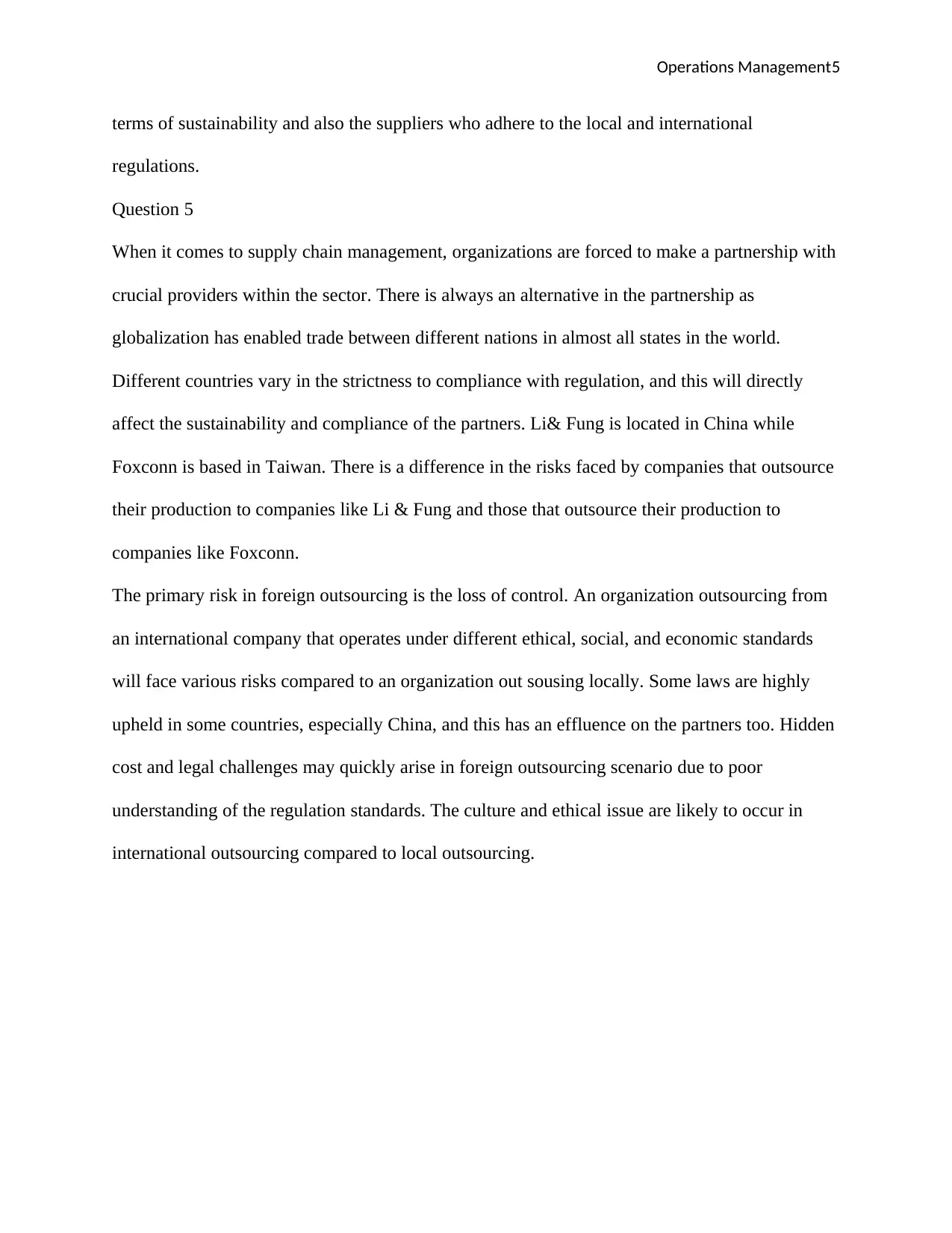
Operations Management5
terms of sustainability and also the suppliers who adhere to the local and international
regulations.
Question 5
When it comes to supply chain management, organizations are forced to make a partnership with
crucial providers within the sector. There is always an alternative in the partnership as
globalization has enabled trade between different nations in almost all states in the world.
Different countries vary in the strictness to compliance with regulation, and this will directly
affect the sustainability and compliance of the partners. Li& Fung is located in China while
Foxconn is based in Taiwan. There is a difference in the risks faced by companies that outsource
their production to companies like Li & Fung and those that outsource their production to
companies like Foxconn.
The primary risk in foreign outsourcing is the loss of control. An organization outsourcing from
an international company that operates under different ethical, social, and economic standards
will face various risks compared to an organization out sousing locally. Some laws are highly
upheld in some countries, especially China, and this has an effluence on the partners too. Hidden
cost and legal challenges may quickly arise in foreign outsourcing scenario due to poor
understanding of the regulation standards. The culture and ethical issue are likely to occur in
international outsourcing compared to local outsourcing.
terms of sustainability and also the suppliers who adhere to the local and international
regulations.
Question 5
When it comes to supply chain management, organizations are forced to make a partnership with
crucial providers within the sector. There is always an alternative in the partnership as
globalization has enabled trade between different nations in almost all states in the world.
Different countries vary in the strictness to compliance with regulation, and this will directly
affect the sustainability and compliance of the partners. Li& Fung is located in China while
Foxconn is based in Taiwan. There is a difference in the risks faced by companies that outsource
their production to companies like Li & Fung and those that outsource their production to
companies like Foxconn.
The primary risk in foreign outsourcing is the loss of control. An organization outsourcing from
an international company that operates under different ethical, social, and economic standards
will face various risks compared to an organization out sousing locally. Some laws are highly
upheld in some countries, especially China, and this has an effluence on the partners too. Hidden
cost and legal challenges may quickly arise in foreign outsourcing scenario due to poor
understanding of the regulation standards. The culture and ethical issue are likely to occur in
international outsourcing compared to local outsourcing.
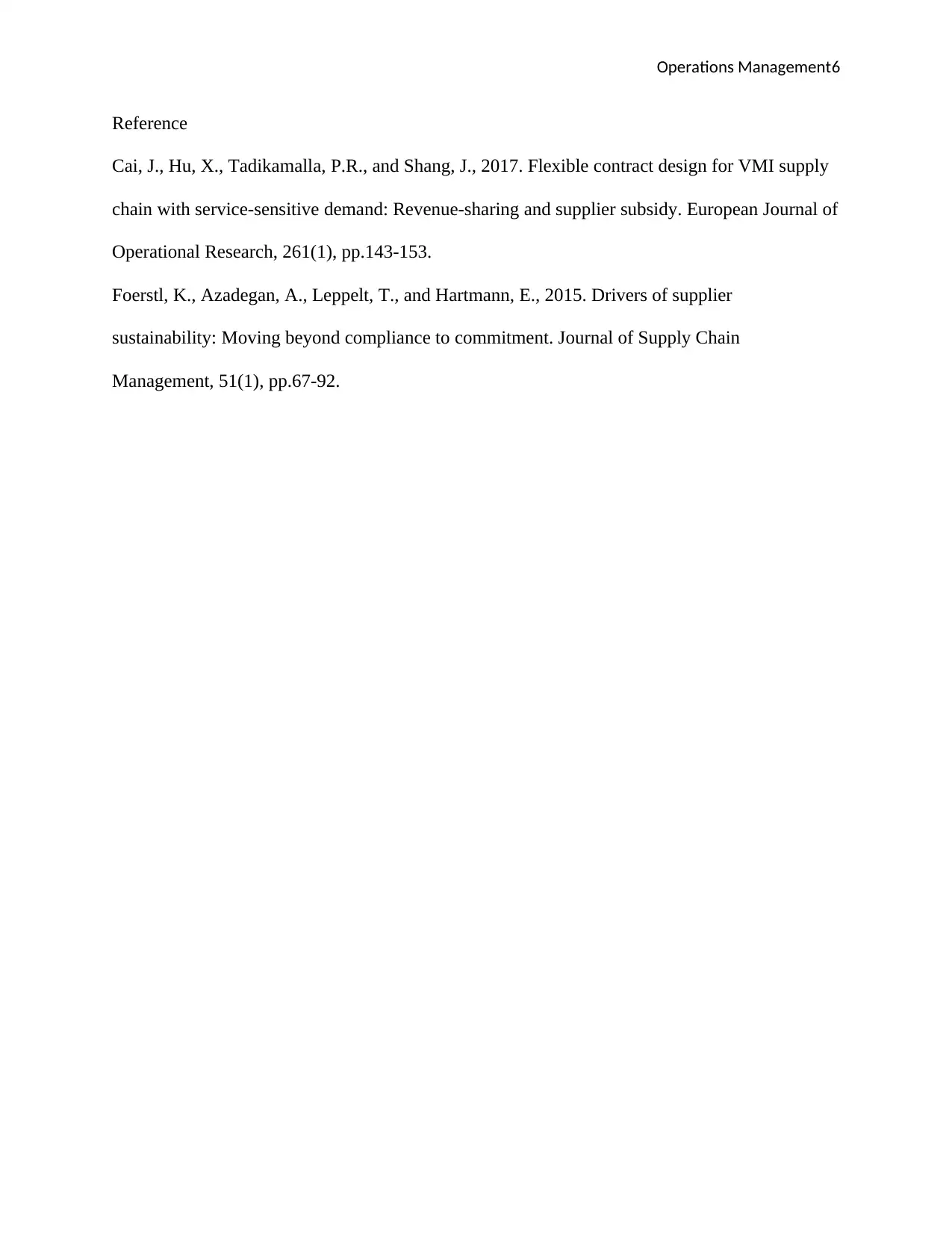
Operations Management6
Reference
Cai, J., Hu, X., Tadikamalla, P.R., and Shang, J., 2017. Flexible contract design for VMI supply
chain with service-sensitive demand: Revenue-sharing and supplier subsidy. European Journal of
Operational Research, 261(1), pp.143-153.
Foerstl, K., Azadegan, A., Leppelt, T., and Hartmann, E., 2015. Drivers of supplier
sustainability: Moving beyond compliance to commitment. Journal of Supply Chain
Management, 51(1), pp.67-92.
Reference
Cai, J., Hu, X., Tadikamalla, P.R., and Shang, J., 2017. Flexible contract design for VMI supply
chain with service-sensitive demand: Revenue-sharing and supplier subsidy. European Journal of
Operational Research, 261(1), pp.143-153.
Foerstl, K., Azadegan, A., Leppelt, T., and Hartmann, E., 2015. Drivers of supplier
sustainability: Moving beyond compliance to commitment. Journal of Supply Chain
Management, 51(1), pp.67-92.
⊘ This is a preview!⊘
Do you want full access?
Subscribe today to unlock all pages.

Trusted by 1+ million students worldwide
1 out of 6
Related Documents
Your All-in-One AI-Powered Toolkit for Academic Success.
+13062052269
info@desklib.com
Available 24*7 on WhatsApp / Email
![[object Object]](/_next/static/media/star-bottom.7253800d.svg)
Unlock your academic potential
Copyright © 2020–2025 A2Z Services. All Rights Reserved. Developed and managed by ZUCOL.





